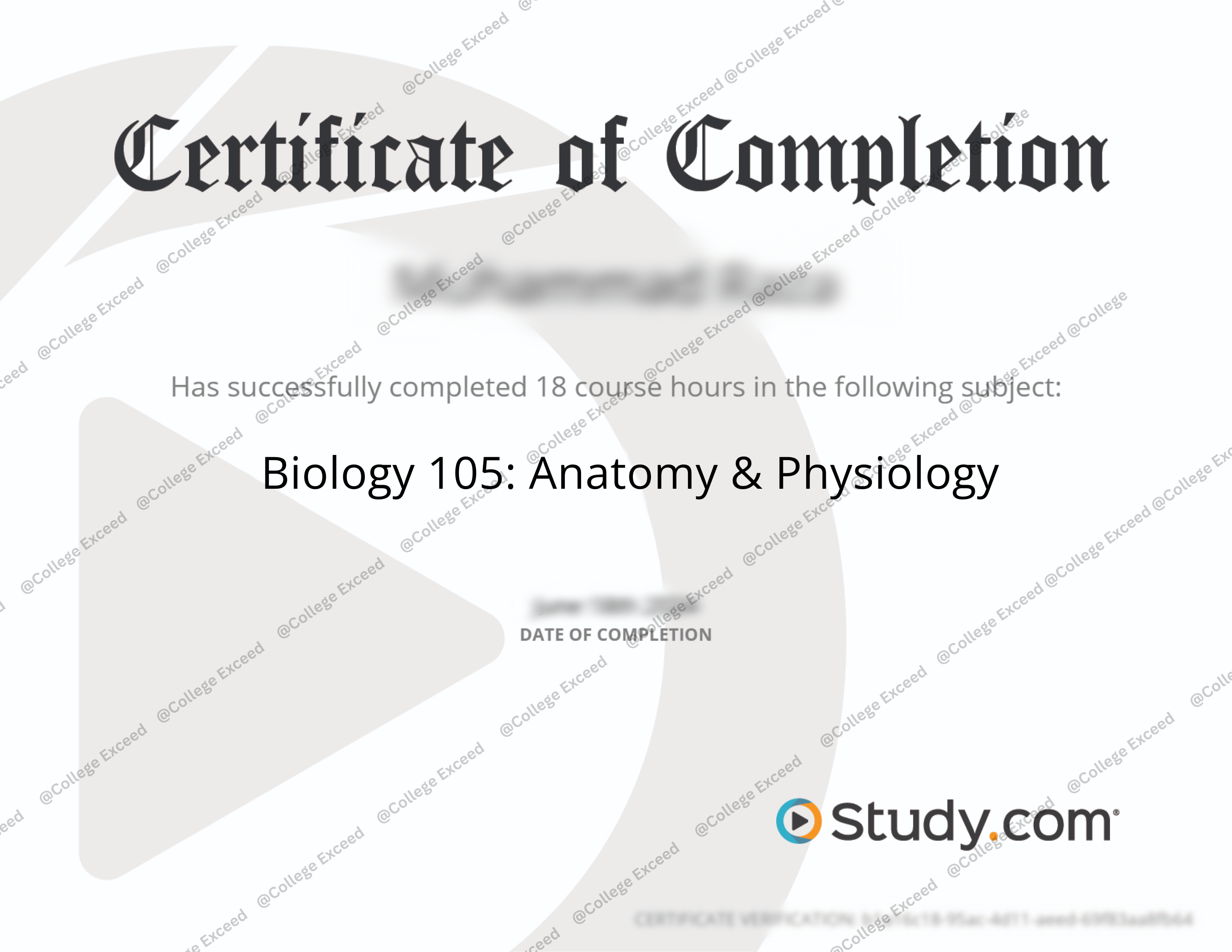
-
Gavin Walton
- October 12, 2024
So, let’s get started with Biology 105: Anatomy & Physiology and simplify the workings of our amazingly wonderful human body. This class, Study.com, is your pathway to learning the complex machinery that controls the functions of our body ranging from breathing, digestion, the circulation of blood, pumping of the heart, processing of information in the brain, and many more. And if sometimes you have ever thought that you’d like to know what it looks like, under the human skin, you are in the right place!
But don’t worry, this doesn’t include the kind of lessons where you sit in front of the teacher with your textbooks opened in front of you. Biology 105 is simple and fun; it is perfect for learners who do not wish to feel that they are struggling in their academics. In addition to fundamental units that make up life, they are going to learn about the endocrine and cardiovascular systems in detail. Furthermore, anatomy and physiology are basic principles to learn when approaching this course and you will be well equipped for the exam when you complete this program. Well then, let’s get comfy and have some snacks of our own while we study together the world of human biology!
---

What to Expect from Study.com Biology 105 Class 📖
So, are you willing to get involved with Biology 105: Anatomy & Physiology at Study.com? Let’s break it down. This class will let you have a glimpse of how the human body is constructed and how it is functioning or in simpler terms the structure and the functioning of the human body. Whether you are preparing to enter the healthcare field or you just want to know what is going on beneath your skin, you will find this course helpful.
In twenty distinct chapters, you are taken through the various systems that exist and allow us to live and breathe. We begin from the simple level in the structure of cells, and types of tissue before moving to the challenging organs including the cardiovascular system, respiratory system, and digestive system. There’s also going to be an equivalent chapter devoted to the nervous system, and if you thought that hormones only run through human veins during puberty, think again because you’re going to learn all about the endocrine system as well as delve into the mechanisms of the reproductive system. Well, of course, we can go through the mechanics, but don’t panic – each concept is explained in a series of minilectures.
But here’s the thing: There are certain areas of knowledge in this class that you are likely to be examined and therefore, some chapters you should focus on in class. For instance, cardiovascular and respiratory muscles are majors in this course and you are most likely to meet them more often in your exams. Furthermore, knowledge of cell biology and the various functions of tissues will form a good background knowledge for the other part of the course. If you’re curious about the level of difficulty, do not worry; it progressively increases like a hike from level 1 to level 7. This way, you’d rarely feel that you are struggling with the topics of discussion as you need to complete weekly lessons. Ready to get started? Now let’s take a look at what the week-to-week study plan would look like to help you excel in this course.
Week-by-Week Study Plan to Ace Study.com Biology 105 Exam📝
To help you stay on track and ace your exams, here’s a week-by-week study plan that will make sure you cover all the essential topics without feeling overwhelmed. Remember, consistency is key!
Week 1: Foundation Building
- Focus on: Chapters 1-3
- Topics: Introduction to Cell Biology, Tissues, and the Integumentary System
- Action Plan: Start by reviewing the basics of cell structure and functions. Understanding cells is crucial since they are the building blocks of everything else you’ll learn. Move on to tissues and the integumentary system, which will help you grasp how cells group together and form the first line of defense for your body.
- Extra Resources: Watch this YouTube video on Cell Biology for a quick refresher.
Week 2: Diving into the Nervous System
- Focus on: Chapters 4-6
- Topics: Nervous System, Brain, and Senses
- Action Plan: This week is all about how your body communicates and processes information. Pay close attention to the structure and function of the brain, and how the nervous system controls everything from muscle movement to memory.
- Extra Resources: Check out this Quizlet set on the Nervous System for quick reviews.
Week 3: Circulatory and Respiratory Systems
- Focus on: Chapters 7-9
- Topics: Cardiovascular System, Blood Vessels, Respiratory System
- Action Plan: These systems are heavily tested, so spend extra time understanding how the heart works, how blood circulates, and how we breathe. Diagrams and flowcharts can be very helpful here.
- Extra Resources: Use this Interactive Cardiovascular System Diagram to visualize the heart and blood vessels.
Week 4: Digestive and Urinary Systems
- Focus on: Chapters 10-12
- Topics: Digestive System, Metabolism, Urinary System
- Action Plan: This week is about how your body processes food and gets rid of waste. Understanding the steps of digestion and how the kidneys filter blood will be important.
- Extra Resources: Watch CrashCourse’s Digestive System Video for an engaging overview.
Week 5: Endocrine System and Reproductive Systems
- Focus on: Chapters 13-16
- Topics: Endocrine System, Male and Female Reproductive Systems
- Action Plan: Learn how hormones regulate everything from growth to reproduction. The reproductive systems might have some memorization-heavy content, so make flashcards for hormones and their functions.
- Extra Resources: Review Khan Academy’s Endocrine System Playlist for detailed explanations.
Week 6: Lymphatic and Immune Systems
- Focus on: Chapter 17
- Topics: Lymphatic System, Immunity
- Action Plan: This week is about your body’s defense mechanisms. Focus on how the lymphatic system supports the immune response and the different types of immunity.
- Extra Resources: Test yourself with Quizlet’s Immune System Flashcards.
Week 7: Review and Reinforcement
- Focus on: All Chapters
- Topics: Comprehensive Review
- Action Plan: This is your week to go over everything you’ve learned. Revisit difficult topics, take practice quizzes, and make sure you understand key concepts. Break your study sessions into manageable chunks, focusing on one system at a time.
- Extra Resources: Use Study.com’s Practice Quizzes to test your knowledge.
Week 8: Final Preparations
- Focus on: Exam Readiness
- Topics: Mock Exams, Key Concept Reviews
- Action Plan: Take full-length practice exams to simulate test conditions. Focus on timing and identifying any weak areas. Review flashcards and summary notes, and make sure you’re confident in the main topics.
- Extra Resources: Try Sporcle’s Anatomy and Physiology Quizzes for a fun way to reinforce your knowledge.
Stick to this study plan, and you’ll walk into the exam room feeling confident and prepared!
---
Best Free Resources for Studying Biology 105 📂
- YouTube Channels
- CrashCourse: is one of the most popular channels that present the materials quickly and interestingly, and they have a playlist with videos about Anatomy & Physiology. Is particularly helpful for graphic and kinesthetic learners and addresses a number of the concepts you will come across in this course.
- Khan Academy: Through the Khan Academy website, learners can get comprehensive tutorials on issues to anatomy and physiology. They make comprehensive videos some of which come with quizzes and exercises at the end to help you gauge your understanding.
- Armando Hasudungan: This channel provides tutorial videos hand drawn with clarity on all aspects of medicine and biology, the cardiovascular, respiratory, and nervous systems included.
- Quizlet Flashcards
- Quizlet is another awesome tool that can be used for memorizing information and for quick revision. You can easily find many flashcard templates that pertain to topics covered in Biology 105 so that you can study for the course and memorize the vital terms and concepts.
- Quizlet – Anatomy & Physiology Flashcards
- Free Practice Quizzes and Tests
- Sporcle: These quizzes can be used to revise in a more colorful approach and one may be able to remember so much.
- Sporcle Anatomy Quizzes
- OpenStax: With this website, you can get free repeating material for Anatomy & Physiology and also there are questions and quizzes at the end of each chapter as well as other features.
- OpenStax Anatomy & Physiology Textbook
- Online Study Groups and Forums
- Reddit: The Anatomy & Physiology subreddit is a learning community where people share staking and materials, answer questions, and help each other. That is why it is useful to find tips on studying and communicating with students.
---
Key Concepts to Focus on in Biology 105🔑
To make sure that you are in good shape to undertake Study.com Biology 201L: Anatomy & Physiology I with Lab, let us break down some important topics you will face in the exam. Here are the areas that you should concentrate on as they are normally the basis of the exam. To make it more comprehensible, we have used some simple relative comparisons, real-life situations, and tables.
- Homeostasis vs. Feedback Mechanisms
- Homeostasis is the body’s ability to create balance in itself while circumstances within and outside it are shifting. Essentially, it serves as the central cock-pit or more to the point, your body’s thermostat that regulates everything.
- Feedback Mechanisms are ways of maintaining equanimity in the body. There are two types:
- Negative Feedback: Serves like a thermostat of a home that you regulate to fit the prevailing weather conditions. In case the temperature decreases the heater is on to increase the temperature of the room. Similarly, if the blood sugar level increases then insulin is released in the body to reduce the same.
- Positive Feedback: This makes amplification occur… For instance, during childbirth, the release of oxytocin stimulates uterine contractions and this in turn stimulates the release of still more oxytocin until the birth of the baby is achieved.
Table: Comparison of Negative and Positive Feedback
Feature | Negative Feedback | Positive Feedback |
|---|---|---|
Purpose | Stabilizes the system | Amplifies a response |
Example | Blood sugar regulation | Childbirth |
End Result | Return to homeostasis | Intensified response until completion |
Frequency | Common in bodily processes | Less common, specific scenarios |
- The Cardiovascular System: Arteries vs. Veins
- Arteries are responsible for pumping oxygenated blood from the heart throughout the body. Much like the arteries of your circulatory system, they’re a high-speed, high-pressure delivery system for the blood.
- Veins ring deoxygenated blood back to the heart. They are similar to sub-arteries; they carry blood at a slower rate and with less pressure; usually, they require valves to obviate blood flow in the opposite direction.
Real-World Example: You may wish to consider arteries as the fast lane of a motorway, where traffic does not halt at all. Veins, however, are similar to local roads with traffic signals in the form of valves to ensure that everything flows as it should.
- The Respiratory System: External vs. Internal Respiration
- External Respiration happens in the lungs where there is an interchange of gases between the air in the alveoli and the blood in the capillaries. It is the point at which oxygen gets into the bloodstream, and carbon gets out of the same.
- Internal Respiration takes place at the tissue level where oxygen is brought to the cells and carbon dioxide removed. It is the last process of reaching out the oxygen to the target site in the body.
Quick Tip: This is the expanded form of ‘external’ which is ‘occurring at the surface level’ these are lung levels) and ‘internal’ which is cellular level (interior of your body).
- Digestive System: Absorption in the Small Intestine
- Most of the absorption takes place in the small intestine. It has, therefore, the lining of villi and microvilli that enhance the area of absorption to ensure that all the nutrients are absorbed from the foods we take.
- Villi and Microvilli have the function of the bristle of a toothbrush that in turn expands the area available to partake in the absorption of nutrients.
Comparison with Real-Life Example: Think of the scenario when you attempt to wipe a liquid stain with a kitchen sponge. The villi and microvilli are like the pores of the sponge that enable as much absorption of liquid (nutrients) as possible.
These are just a few of the concepts that I have found valuable, however grasping them will provide a solid grounding for the Study.com Biology 105: Anatomy & Physiology exam. It is important to focus on the mentioned topics, learn the differences and similarities, and where possible illustrate such differences and similarities using examples.
---
Study.com Biology 105 FAQ ❓
Q1: What’s the best way to study?
A: Break the material into small chunks and follow the week-by-week plan. Use flashcards, videos, and practice quizzes for reinforcement.
Q2: How much time should I study weekly?
A: Aim for 6-8 hours per week. Adjust based on your comfort with the material.
Q3: Which topics are most important?
A: Focus on homeostasis, cardiovascular, respiratory, and digestive systems. These areas are heavily tested.
Q4: How do I use flashcards effectively?
A: Review them daily and focus on one category at a time. Use spaced repetition for tough terms.
Q5: What if I don’t get a concept?
A: Try a different learning method like videos or diagrams. Revisit the topic later with a fresh perspective.
Q6: Do I need to memorize everything?
A: Understand key concepts first. Details will be easier to remember once you grasp the main ideas.
Q7: How can I reduce exam stress?
A: Prepare early and practice relaxation techniques. Ensure you’re well-rested before the exam.
---
Final Thoughts on Succeeding in Biology 105 📄
It might look very daunting to study for “study.com Biology 105: Anatomy & Physiology” but with these guidelines and helpful tools, it is very easy. However, in order to undertake the preparation systematically and effectively and avoid any last-minute confusion, the following steps shall be followed: The material should be divided into sections for easy understanding, external sources can be used to gain an improved understanding and, in particular, the rigid schedule should be followed. However, no matter how much effort is put into studying, it is important to understand that frequency of revision is very important if a candidate is to retain knowledge. Do not allow your motivation to drop, continue going over difficult material and never hesitate to ask for help. You have tried, and with this approach, you have been placed on a pedestal to score well in the course. Good luck, and happy studying!: Good luck to everyone and I hope you all pass your classes with flying colors.



